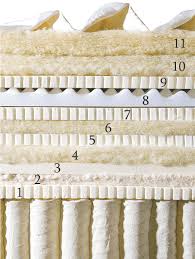Mattress Construction
August 2013Kluft mattress dissection
If we start at the springs and work our way up, we will be able to see what happens as you lay on this particular mattress.

Note: We do not have the actual specification of this particular mattress and the breakdown below is pretty much-educated guesswork.
Springs: We can see that these are calico encased and individually sewn and laced looks like a six turn cylindrical unit in the region of 1800 springs.
First layer: The insulating layer is a layer of latex looks about 2cm deep. Perfect material to work with the slightest movement on the springs.
Second layer: This looks like cotton felt, probably 600 GSM, going by the depth. We are assuming this is to provide a cushioning layer to the forthcoming foam layer.
Third layer: Not too sure what this product is. It looks like a soft low-density foam. Estimate 2cm in height.
Fourth layer: A wool blend of sorts. probably blended with mohair and silk. Estimate 600 GSM.
Fifth layer: Latex Estimate 2cm
Sixth layer: Wool blend. Looks like a wool and cotton blend. Estimate 600 GSM.
Seventh layer: Latex – Estimate 2cm
Eighth layer: Biofoam (Soft) estimate 3cm. The convolutions are supposed to encourage airflow. Read our thoughts on this below.
Ninth layer: Latex -Estimate 2cm
Tenth and eleventh layers: The description states that more than 10lbs (4.5kg) of blended cashmere, mohair, silk and New Zealand wool is used as the comfort layers. Going by the visual it looks like a combined weight of all fibre usage.
Conclusion of Kluft dissection
This is quite an impressive build which for around £22000 it would have to be. The use of soft fibres between the latex layers is a very interesting concept enabling the latex layers to remain independent.
The one thing which we don’t understand fully is that this mattress comes in at a depth of just over 19 inches before tufting. If we estimate the height of the spring unit and base support layer (not visible on image) as being 6 inches (spring) and one inch (base support) that leaves around 13 inches (33cm) of upholstery.
The finished mattress height is just over 14 inches (36cm) which mean that after being tufted (by hand) the upholstery is condensed by about 5 inches (13cm).
Looking at the Biofoam layer, the description states that this arrangement will improve airflow – However, surely this will be completely negated as the crowns on the foam will be completely compacted after tufting (thoughts please).
Taking that the mattress is 19 inches in height (pre tufting) we can estimate that seven (18cm) of those is Spring and Base Support leaving approx 12 inches (30cm) for all these upholstery layers which give rise to our estimates of 13cm of latex and foam and around 17cm of high loft fibres. As the finished mattress is 36cm we think that the compression of upholstery from 30cm to 18cm (5 inches) will give a mattress that will be on the firmer side.
Summary
As we said at the beginning of this post, this is an extremely interesting design concept. Over the next few months, we are going to try and replicate this particular mattress to see what the end result will be. Like the Kluft image above we give the exact components used in all of our mattresses giving cutaways in every product description in our Shop. If you need more help, because let’s be honest, its a very confusing world with beds, give our small expert team a call for assistance.

Dreaming of the perfect nights sleep?

Ask us a question
There are over 6000 questions and answers submitted by you on all questions about mattresses and bed problems. Enter a keyword such as Vi Spring, John Lewis beds, bad back or Memory Foam and see if your question has already been answered.
If you can’t find an answer in knowledge hub, ask a new question. We aim to respond to all questions within one working day.
Newsletter
Enter your email to join our newsletter. We’ll send you occasional news and mattress expertise.
